Improve facial aesthetics
Anchorage can be used to modify the growth of the jaws, especially for children with excessive growth of the lower jaw, and a prominent chin.
How does it work?
Skeletal anchorage can be used to modify the growth of the jaws. Especially in children with excessive growth of the lower jaw, and a prominent chin, a bone anchor can be inserted in the posterior part of the upper and in the anterior part of the lower jaw.
Light elastics are fixed between the upper and lower anchors and result in a restriction of the growth of the lower jaw
and a stimulation of the growth of the upper jaw.
These growth changes reduce the prominence of the chin and improve facial aesthetics. Moreover, the upper and lower teeth will fit better.

FAQ
Frequent Asked Questions
The goal of this treatment is to stimulate the growth of the upper jaw and to restrain the growth of the lower jaw. The amount of the growth changes cannot be predicted and is different from one patient to another. The combination of growth changes in upper and lower jaw results in an improvement of the bite and facial aesthetics with a less prominent chin.
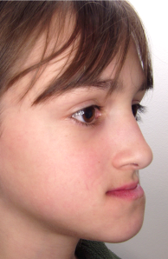
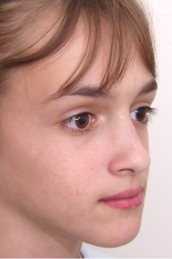
Your orthodontist may give you some plastic auxiliary that may help you the first days to fix the elastics but very quickly you will learn to put the elastic at the top of your index finger and fix it on the hook of the upper bone anchor first and then stretch it and fix it to the bottom one.
It is very important that you fix the elastic only around the hook and not around the whole extension of the bone anchor, which may lead to irritation of the gums.
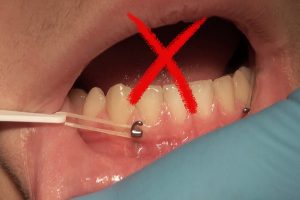
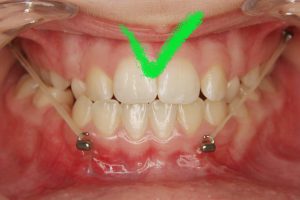
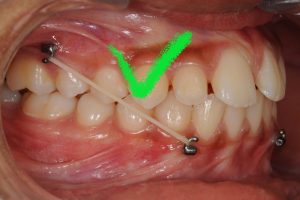
Your orthodontist will give you the appropriate elastics. During the first 3 to 4 months the size of the elastics will be gradually changed to increase the forces slightly.
The elastics have to be worn 24 hours a day, also during eating and to sleep with. You have to remove the elastics for brushing your teeth, and replace them by new ones every morning and evening.
Commonly the elastics are used for one year, followed by a treatment with fixed appliance.
Cleaning of the anchors is very important to avoid local infections. Use a soft hand brush without tooth paste, retract your lower lip and open the mouth only slightly. You brush around the bone anchor making small gentle movements.
For brushing the upper anchors, you retract the cheek with one hand and put the hand brush above the teeth in front of the bone anchor. You brush around the bone anchor making small gentle movements.
After cleaning the 4 anchors you brush your teeth with a manual or electric tooth brush and tooth paste.
Especially after the surgery, because of the swelling of the lip and cheeks, some irritation of the mucosa in front of the bone anchor may occur. In this case you can cover the bone anchor with a small amount of soft orthodontic wax. You can easily remove it before brushing and replace it by a new piece of wax after brushing. After a couple of days, when the irritation disappeared, you can stop the application of wax.
The best age is between 11 and 13 years. Before the age of 11 the bone where the anchors are fixed may be too thin or too soft, which may reduce the stability of the screws. The strength of the bone increases with age.
After 13 years, the growth is slowing down and the effect of the treatment will be smaller. Especially girls stop their growth earlier than boys.
The bone anchors can be inserted under local aneasthesia, sedation or general aneasthesia. Which option is the best for you should be discussed with your orthodontist or surgeon.
Because of the anaesthesia, the surgery is out of pain. As after the removal of wisdom teeth, you may expect a swelling of the cheeks for about 3 days. The amount of swelling is variable and can be reduced by ice application after the surgery.
After wearing the elastics for about 1 year, usually a treatment with fixed appliance is still needed to straighten your teeth. During but also after this orthodontic treatment the bone anchors are maintained. It happens that after removal of the fixed appliance some excessive growth of the lower jaw still occurs. Then elastics may still be needed to stabilize the correction.
Depending on the evolution of your growth, your orthodontist will advise you when to remove the anchors. Removal of the anchors is most commonly done under local anaesthesia.
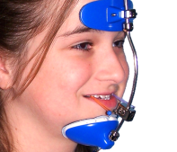

A face mask can also be used to stimulate the growth of the upper jaw. It is an extra-oral appliance which is worn 14 hours a day whereas with bone anchors elastics can be worn day and night.
With a face mask the elastics are fixed to a tooth supported orthodontic appliance in the upper jaw. This results in more tooth displacement and less growth changes.
Commonly double as much growth changes are obtained with bone supported anchorage compared with face mask.
This may happen when the bone is very thin and weak at the place the anchor has been inserted by the surgeon. That’s why it is recommended not to start this treatment before the age of 11. Another cause may be bad oral hygiene or jiggling forces due to repeatedly touching the bone anchors by your fingers or tongue or by playing with the elastics on the bone anchors.
If exceptionally mobility occurs, you stop wearing the elastics, avoid jiggling forces, and see your orthodontist for advice. After interruption of the elastics and with better oral hygiene, the bone anchor can get fixed again. If mobility persists, the bone anchor should be removed under local anaesthesia and replaced 2 to 3 months later.